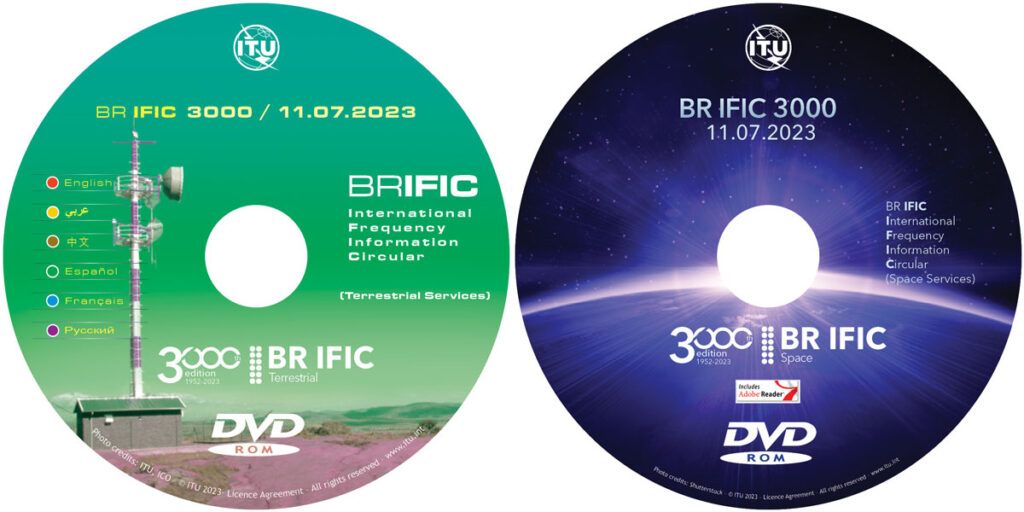
Keeping interference in check: Seven decades of ITU’s radio frequency circular
By ITU News
For over 70 years, the International Telecommunication Union (ITU) has been publishing its key radiocommunication circular, an important notice containing information on global radio frequency assignments.
On July 11, the ITU Radiocommunication Bureau (BR) released the landmark 3,000th edition of the publication, known in the field as the BR International Frequency Information Circular (BR IFIC).
The BR IFIC – published every two weeks pursuant to Article 20 of the Radio Regulations – contains the particulars of frequency assignments recorded in the Master International Frequency Register (MIFR) and Worldwide/Regional Plans for space and terrestrial services, along with the notices for proposed new assignments.
The Radio Regulations, specifically RR No. 1.18, define “assignment” (of a radio frequency or radio frequency channel) as the “Authorization given by an administration for a radio station to use a radio frequency or radio frequency channel under specified conditions.”
A frequency assignment recorded in the MIFR enjoys international recognition and protection from harmful interference.
The history of the BR IFIC is entwined with ITU’s core mandate to facilitate interference-free communications worldwide. ITU maintains the key Radio Regulations treaty and supports coordination among countries and radio services worldwide, particularly to deconflict potentially incompatible spectrum uses.
Why the BR IFIC matters
As radio-based technologies become more sophisticated and digital ecosystems expand, the airwaves are becoming increasingly crowded. This elevates risks of harmful interference in the world’s limited radio frequency spectrum.
Harmful radio interference can disrupt broadcasting signals, mobile and fixed communications systems, and a growing array of vehicle navigation and time-geolocation networks. It also affects scientific services that are vital to monitor climate change and the planet’s health.
Following the Titanic disaster in 1912, governments agreed on allocating a dedicated frequency for distress calls and adopted regulations to prioritize distress calls over other telegraph calls.
The International Radiotelegraph Conference held in Washington in 1927 established a table for frequency allocations to different services. Until then, countries could use almost any available frequency as they saw fit, simply notifying ITU – formally the International Telegraph Union until 1934 – of their use of the frequency for publication in the International Frequency List.
But this free-for-all scenario led to chaos amid the rapid expansion of radio services. By the late 1940s, as more countries launched new services in the congested spectrum, the risks of harmful interference had become intolerable.
Radio-frequency experts at the time expressed fears that ground-to-air communication was compromised, and civil aircraft could no longer fly safely. Broadcasting services became more frequently garbled.
Global frequency harmonization
ITU’s Atlantic City Radio Conference in May 1947 restored order to the sector by creating the International Frequency Registration Board (IFRB). Later the same year, ITU became a specialized agency in the newly created United Nations system.
The IFRB had a mandate to:
- Maintain a register of all radio frequencies used for all purposes throughout the world.
- Ensure no frequency was used by any country if this caused interference for radio stations already in operation in line with the Radio Regulations.
The new Board thus became the custodian of the MIFR, containing all frequency assignments to radio stations as notified by administrations worldwide. ITU in turn started periodically publishing the details of all frequency assignments recorded there, for the guidance and benefit of countries worldwide.
Thus, the key ITU radiocommunication circular – the BR IFIC’s forerunner – started in October 1952. ITU Member States were invited to send telegrams to the IFRB with any objections or comments on frequency assignments within two weeks of each edition.
Stepping into the digital future
The original circular, printed on paper, became more voluminous each time. By the late 1980s, many sections were converted to microfiche – a thin, flat sheet of transparent photographic film containing a grid of small-scale page reproductions.
Another update came in 1991, with the Weekly Information Circular on a floppy diskette complementing the microfiche and paper versions.
Reforms at ITU in 1992 brought the merger of the International Radio Consultative Committee (CCIR) – the predecessor of today’s ITU-R Study Groups – and the IFRB Secretariat into the ITU Radiocommunication Sector (ITU-R). This new structure would be served by ITU’s Radiocommunication Bureau, with the part-time Radio Regulations Board (RRB) replacing the full-time IFRB.
The circular’s 2,410th edition, published in January 2000, was the first to officially carry the name “BR IFIC” (usually pronounced “Brific”). At the same time, the Radiocommunication Bureau started distributing the BR IFIC in standard digital disc formats (CD-ROM) every two weeks, replacing the former paper, microfiche, and diskette versions.
Given the large volume of data involved, the BR IFIC circular comes in two parts: Terrestrial Services and Space Services. The BR IFIC made the transition from CD-ROM to DVD-ROM starting with the version for Terrestrial Services subscribers in 2005.

The future of the BR IFIC
After more than 70 years, the ITU information circular on radio frequencies remains a pillar of global spectrum management. Every two weeks, the BR IFIC provides essential information on all frequency assignments worldwide.
This lets countries to assess whether any new assignment could affect their own planned or existing radio systems – and to address this through international coordination where necessary.
ITU’s Radiocommunication Bureau aims to keep making the BR IFIC more accessible, notably by developing online tools to facilitate consultations of the BR IFIC data, as well as subsequent application of the procedures of the Radio Regulations and related regional agreements.
Stay tuned for BR IFIC 4,000 in 2063!
Header image credit: Adobe Stock
